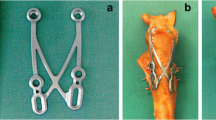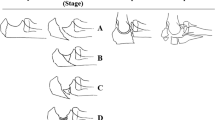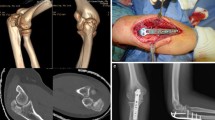Abstract
Introduction
Tension band wiring (TBW) used for olecranon fractures is afflicted with a high rate of complications. The aim of this study was to compare the stability of the TBW versus an alternative, novel low-profile olecranon tension plate (OTP) with angular stable screws in a simulated complex fracture model.
Materials and methods
Nine fresh-frozen pairs of cadaver proximal ulnae with an oblique osteotomy and an additional wedge fragment simulating an unstable fracture were tested. The TBW and OTP were implanted pairwise. The elbow motion was simulated in a single-muscle model and ranged from full extension to 90° of flexion. The pulling force of the triceps tendon ranged from 50 to 200 N. The displacement of the fracture fragments was measured with a video motion analysis system over 304 cycles. Data were assessed statistically using the Wilcoxon signed-rank test.
Results
The cyclic loading tests showed mean loosening of the fracture fragments at the articular surface of 0.56 mm using TBW (SD 0.65) and 0.15 mm for OTP (SD 0.39). There was no statistical significance in loosening between the two constructs (p = 0.31). No plate breakage or screw loosening occurred.
Conclusions
The low-profile OTP, using the principles of pre-tensioning, lag, cortical, and angular stable screws together, demonstrated similar stability after olecranon fracture fixation when compared with the TBW technique and a lag screw in the olecranon fracture model with a third wedge fragment.





Similar content being viewed by others
References
Karlsson MK, Hasserius R, Karlsson C et al (2002) Fractures of the olecranon: a 15- to 25-year followup of 73 patients. Clin Orthop Relat Res 204:205–212. doi:10.1097/01.blo.0000022181.66847.50
Rommens PM, Küchle R, Schneider RU, Reuter M (2004) Olecranon fractures in adults: factors influencing outcome. Injury 35:1149–1157. doi:10.1016/j.injury.2003.12.002
Veillette CJH, Steinmann SP (2008) Olecranon fractures. Orthop Clin N Am 39:229–236. doi:10.1016/j.ocl.2008.01.002
Newman SDS, Mauffrey C, Krikler S (2009) Olecranon fractures. Injury 40:575–581. doi:10.1016/j.injury.2008.12.013
Wiegand L, Bernstein J, Ahn J (2012) Fractures in brief: olecranon fractures. Clin Orthop Relat Res 470:3637–3641. doi:10.1007/s11999-012-2393-5
Ruedi T, Buckley R, Moran C (2007) AO principles of fracture management. Thieme Medical Publishers, Stuttgart
Chalidis BE, Sachinis NC, Samoladas EP et al (2008) Is tension band wiring technique the “gold standard” for the treatment of olecranon fractures? A long term functional outcome study. J Orthop Surg Res 3:9. doi:10.1186/1749-799X-3-9
Claessen FMAP, Braun Y, Peters RM et al (2016) Factors associated with reoperation after fixation of displaced olecranon fractures. Clin Orthop Relat Res 474:193–200. doi:10.1007/s11999-015-4488-2
Baecher N, Edwards S (2013) Olecranon fractures. J Hand Surg Am 38:593–604. doi:10.1016/j.jhsa.2012.12.036
Brink PRG, Windolf M, de Boer P et al (2012) Tension band wiring of the olecranon: is it really a dynamic principle of osteosynthesis? Injury. doi:10.1016/j.injury.2012.08.052
Wolfgang G, Burke F, Bush D et al (1987) Surgical treatment of displaced olecranon fractures by tension band wiring technique. Clin Orthop Relat Res 224:192–204
Fyfe IS, Mossad MM, Holdsworth BJ (1985) Methods of fixation of olecranon fractures. An experimental mechanical study. J Bone Joint Surg Br 67:367–372
Tarallo L, Mugnai R, Adani R et al (2014) Simple and comminuted displaced olecranon fractures: a clinical comparison between tension band wiring and plate fixation techniques. Arch Orthop Trauma Surg 134:1107–1114. doi:10.1007/s00402-014-2021-9
Wellman DS, Lazaro LE, Cymerman RM et al (2015) Treatment of olecranon fractures with 2.4- and 2.7-mm plating techniques. J Orthop Trauma 29:36–43. doi:10.1097/BOT.0000000000000152
Hutchinson DT, Horwitz DS, Ha G et al (2003) Cyclic loading of olecranon fracture fixation constructs. J Bone Joint Surg Am 85-A:831–837
Mullett JH, Shannon F, Noel J et al (2000) K-wire position in tension band wiring of the olecranon—a comparison of two techniques. Injury 31:427–431
Prayson MJ, Williams JL, Marshall MP et al (1997) Biomechanical comparison of fixation methods in transverse olecranon fractures: a cadaveric study. J Orthop Trauma 11:565–572
Romero JM, Miran A, Jensen CH (2000) Complications and re-operation rate after tension-band wiring of olecranon fractures. J Orthop Sci 5:318–320. doi:10.1007/s007760000050318.776
Candal-Couto JJ, Williams JR, Sanderson PL (2005) Impaired forearm rotation after tension-band-wiring fixation of olecranon fractures: evaluation of the transcortical K-wire technique. J Orthop Trauma 19:480–482
Catalano LW, Crivello K, Lafer MP et al (2011) Potential dangers of tension band wiring of olecranon fractures: an anatomic study. J Hand Surg Am 36:1659–1662. doi:10.1016/j.jhsa.2011.07.001
Schneider MM, Nowak TE, Bastian L et al (2014) Tension band wiring in olecranon fractures: the myth of technical simplicity and osteosynthetical perfection. Int Orthop 38:847–855. doi:10.1007/s00264-013-2208-7
Amini MH, Azar FM, Wilson BR et al (2015) Comparison of outcomes and costs of tension-band and locking-plate osteosynthesis in transverse olecranon fractures: a matched-cohort study. Am J Orthop 44:E211–E215
Gruszka D, Arand C, Nowak T et al (2015) Olecranon tension plating or olecranon tension band wiring? A comparative biomechanical study. Int Orthop 39:955–960. doi:10.1007/s00264-015-2703-0
Ikeda M, Fukushima Y, Kobayashi Y, Oka Y (2001) Comminuted fractures of the olecranon. Management by bone graft from the iliac crest and multiple tension-band wiring. J Bone Joint Surg Br 83:805–808
Todisco M, Trisi P (2005) Bone mineral density and bone histomorphometry are statistically related. Int J Oral Maxillofac Implants 20:898–904
Labitzke R (1975) The lateral tension band. Demonstrated for fractures of the olecranon (author’s transl). Arch Orthop Unfallchir 81:193–198
Nowak TE, Mueller LP, Burkhart KJ et al (2007) Dynamic biomechanical analysis of different olecranon fracture fixation devices—tension band wiring versus two intramedullary nail systems: an in vitro cadaveric study. Clin Biomech (Bristol, Avon) 22:658–664. doi:10.1016/j.clinbiomech.2007.02.003
Rawson S, Cartmell S, Wong J (2013) Suture techniques for tendon repair; a comparative review. Muscles Ligaments Tendons J 3:220–228
Nordin M, Frankel V (2001) Basic biomechanics of the musculoskeletal system, 3rd edn. Lippincot Williams and Wilkins, Philadelphia
Wilson J, Bajwa A, Kamath V, Rangan A (2011) Biomechanical comparison of interfragmentary compression in transverse fractures of the olecranon. J Bone Joint Surg Br 93:245–250. doi:10.1302/0301-620X.93B2.24613
Bailey CS, MacDermid J, Patterson SD, King GJ (2001) Outcome of plate fixation of olecranon fractures. J Orthop Trauma 15:542–548
Hume MC, Wiss DA (1992) Olecranon fractures. A clinical and radiographic comparison of tension band wiring and plate fixation. Clin Orthop Relat Res 285:229–235
Kozin SH, Berglund LJ, Cooney WP et al (1996) Biomechanical analysis of tension band fixation for olecranon fracture treatment. J Shoulder Elbow Surg 5:442–448
Buijze GA, Blankevoort L, Tuijthof GJM et al (2010) Biomechanical evaluation of fixation of comminuted olecranon fractures: one-third tubular versus locking compression plating. Arch Orthop Trauma Surg 130:459–464. doi:10.1007/s00402-009-0980-z
Wu CC, Tai CL, Shih CH (2000) Biomechanical comparison for different configurations of tension band wiring techniques in treating an olecranon fracture. J Trauma 48:1063–1067
Ren Y-M, Qiao H-Y, Wei Z-J et al (2016) Efficacy and safety of tension band wiring versus plate fixation in olecranon fractures: a systematic review and meta-analysis. J Orthop Surg Res 11:137. doi:10.1186/s13018-016-0465-z
Acknowledgements
This manuscript is based on the analysis of data included in the Dr. Med. Thesis of CA.
Author information
Authors and Affiliations
Corresponding author
Ethics declarations
Conflict of interest
The biomechanical laboratory of the Department of Trauma Surgery is supported by a yearly grant from Medartis AG, Basel, Switzerland. No direct benefits in any form have been or will be received from a commercial party related directly or indirectly to the subject of this study by any of the authors.
Ethical approval
Written approval from the Ethics Committee of the Landesaerztekammer of Rhineland-Palatinate, Mainz, Germany (Approval No. 837.088.07 from 03 April 2007).
Rights and permissions
About this article
Cite this article
Gruszka, D., Arand, C., Greenfield, J. et al. Is the novel olecranon tension plate a valid alternative to tension band wiring of olecranon fractures? A biomechanical study on cadaver bones. Arch Orthop Trauma Surg 137, 1651–1658 (2017). https://doi.org/10.1007/s00402-017-2760-5
Received:
Published:
Issue Date:
DOI: https://doi.org/10.1007/s00402-017-2760-5




